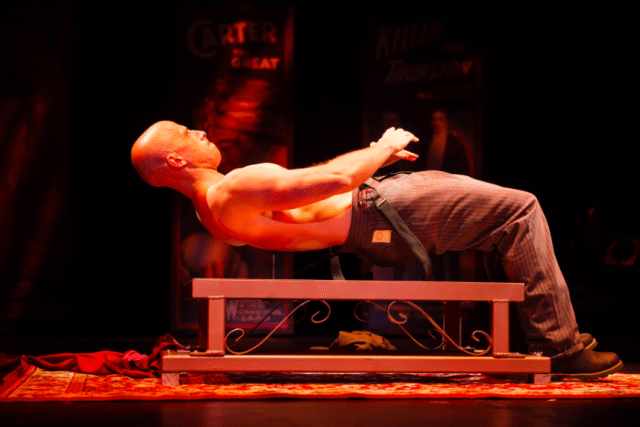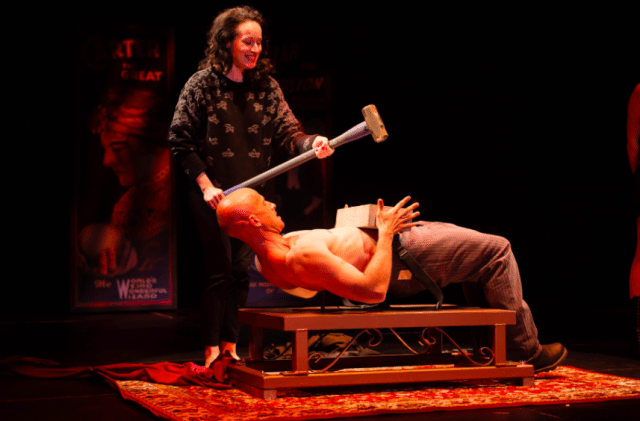

Whether he’s hanging from the London Eye, or floating over metal pikes at the Palace Theatre in New York City, escapologist/daredevil Jonathan Goodwin always keeps the audience enthralled. Defying the odds, he’s been able to conquer heights, gravity and burning ropes, all to provide the kind of grand spectacle that makes audience members chew their nails, and sometimes cover their eyes in fear and awe. As part of the incredible troupe of The Illusionists: Turn of the Century he’s bringing pure wonder to Broadway, where show after show he secures thunderous applause. I spoke to him recently about his preparation, his role models, and his evident love of history.
I took my 10 year-old niece to see the show and she came out wanting to do everything you did…
I’m sorry.
...what’s your advice for children who want to become daredevils?
Firstly don’t, because I don’t need the competition. Second, what I do is dangerous and requires a huge amount of preparation and training. You can tell very quickly if someone is genuinely interested in doing this, or they’re just playing. We always tell them not to try what we do at home, with good reason. I read a book on Houdini when I was 7 and it became very serious to me, it takes a long time to get to the place where you can safely and reliably do the things that I do. I would tell children to find a mentor, whether it be gymnastics or circus, and start to build the building blocks for that way of life and thinking. I do lots and lots of different things, I collect dangerous and stupid skills, but in order to do that effectively I need to have complete knowledge and confidence in my abilities. Body awareness is the basis of everything I do.
The more I see illusion and magic shows, the clearer it becomes that people who do this have such a love of history, which is why I was so excited that the show this year is a celebration of early illusionists. It’s so important that young people become aware of the importance of history, besides Houdini, can you talk about other historical figures who inspired you?
For me the inspiration for what I do comes from the period in time that this show celebrates. The job that I do doesn’t exist now, but it existed then. At the beginning of the show I say that whenever you say the word “daredevil”, you think of someone who’s sponsored by an energy drink, but 100 years ago that character was someone who was doing stuff theatrically. Houdini dangled from a rope in Times Square, or Charles Blondin the tightrope walker was going across Niagara Falls, they were doing it for the spectacle, for the audience, whether or not they were being filmed or sponsored or not. During that time there were no risk assessments or insurance, so it was truly unbridled creativity, you had a crazy idea and no one was going to stop you from doing it.
One of the things that always makes me laugh about this time period was the element that when you wanted to make something more impressive, you added a lion. Charles Blondin exhibited at the Crystal Palace and walked a tightrope higher than Niagara Falls, he got in trouble because the first time he did the exhibition he wheeled his daughter in a wheelbarrow from one side to the other, and everybody thought it was really distasteful. The press wrote mean things about him, so he stopped doing it with his daughter and started doing it will a full grown male lion instead. Everybody was happy with that. There’s also the wall of death, which is less common now, but back in the day they were really big and they would drive cars around and this lady called Ethel Purtle drove a car with a sidecar and a lion called King on the sidecar. If you Google her you’ll find a photo of the lion grinning ear to ear in the car, it’s amazing. My job is to recreate that world for a modern audience.
The things I’ve seen you do always make me think of Buster Keaton, Charles Chaplin and Harold Lloyd. You’re also a consultant for films and television, what action sequence from the past would you have loved to work in?
I’m absolutely flattered because you just listed some of my biggest idols, add Stan Laurel and Douglas Fairbanks to that list and outside of the vaudeville world, those people are my biggest inspiration. Keaton particularly was just extraordinary, he did things we haven’t seen since, there’s a fantastic sequence in one of his movies where he runs into the middle of the street and a towncar goes past, and he just grabs the back of it, his legs collapse underneath him and he is pulled down the street. It’s truly breathtakingly amazing, the amount of body strength that you have to have in order to be able to do that is extraordinary. I’m sure you can find a strongman or athlete to recreate that scene, but the thing about Keaton is he could sell it, he could perform it, he could do that and have his famous stone face.
Since you’re in New York, if you ever have any time off the show, what shows would you like to go see?
I’m a big circus fan, so I’d love to see Paramour. I took my 4 year-old daughter to see Mother Africa circus at the New Victory Theater which was great. It had very talented people and gave a big spin on some circus acts, it was so well done. Obviously I’d love to see Hamilton, but I don’t see that happening anytime soon, or at least while we’re still here.
How do you select the act you’ll do in the show?
That isn’t my choice, I present the things I do to the producers and they pick. There’s a certain amount of input I can have, but one of the abiding decision making processes in my choice this year was that I was here last year, so I had to do new things. You think of the things you can do on a Broadway stage, the act I do in the show was created specifically for Broadway.

I was shocked to discover that you were afraid of heights. Does your work help you master your fear in any way?
Not really, I have a fear of heights and I can compartmentalize it and get over it, but it doesn’t go away. If I’m at the top of a building, I still get that feeling in my stomach, I would get worried if I didn’t have that fear. I combat the fear with knowledge of my abilities and the minutiae of the stunt. The things I do are very uncommon, what I have is a lot of rehearsal and preparation. The comparison I always make is when you walk down a busy street, cars flying past you, you don’t panic you’ll get run over because you trust your ability to step back and not get hit. You trust your physical ability to do that.
You’re a motivational speaker, but what’s the best single piece of advice you’ve received?
From the point of view of my business, and life in general, and how to deal with opportunity, I think if I have any great skills I need to put faith in them. When I was a child I wrote a letter to a famous industry consultant who rather than writing back called me. One of the things he said to me was “if every anybody asks you: can you do something? Your answer is yes! After you’ve said yes, then you worry about how to do it”. There is an abiding impetus that occurs when you have a challenge or a deadline, while if you think you can’t do something then you never will.
For people call you “danger man”, what would surprise them the most about you?
(Laughs) That I’m absolutely not an adrenaline junkie at all. To me it’s a little bit like a busman’s holiday, once I was gifted a skydiving course and I said “thank you, but I don’t want that”. It seemed like an unnecessary risk to me. I don’t mind doing things when I’m being paid, or as part of a show, but if it’s just my entertainment, I’d rather go watch a movie or read a good book.
For tickets and more information on The Illusionists: Turn of the Century click here.